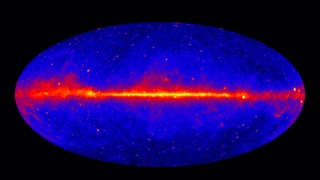Highlights of Fermi's First Five Years
This compilation summarizes the wide range of science from the first five years of NASA's Fermi Gamma-ray Space Telescope. Fermi is a NASA observatory designed to reveal the high-energy universe in never-before-seen detail. Launched in 2008, Fermi continues to give astronomers a unique tool for exploring high-energy processes associated with solar flares, spinning neutron stars, outbursts from black holes, exploding stars, supernova remnants and energetic particles to gain insight into how the universe works.
Fermi detects gamma rays, the most powerful form of light, with energies thousands to billions of times greater than the visible spectrum.
The mission has discovered pulsars, proved that supernova remnants can accelerate particles to near the speed of light, monitored eruptions of black holes in distant galaxies, and found giant bubbles linked to the central black hole in our own galaxy.
From blazars to thunderstorms, from dark matter to supernova remnants, catch the highlights of NASA Fermi’s first five years in space.
View all the Fermi-related media from the last 5 years in the Fermi Gallery.
For more information about Fermi, visit NASA's Fermi webpage.
Short video containing highlights from Fermi's first 5 years of operation.
Watch this video on the NASAexplorer YouTube channel.
For complete transcript, click here.
For More Information
Credits
Please give credit for this item to:
NASA's Goddard Space Flight Center
-
Animators
- Walt Feimer (HTSI)
- Scott Wiessinger (USRA)
- Cruz deWilde (Avant Gravity)
-
Video editor
- Scott Wiessinger (USRA)
-
Interviewees
- Julie McEnery (NASA/GSFC)
- Eric Stoneking (NASA/GSFC)
- Roger Romani (Stanford University)
-
Narrators
- Scott Wiessinger (USRA)
- Erin McKinley (OSU)
- Genna Duberstein (USRA)
- Chris Smith (HTSI)
- Karen Fox (ADNET Systems, Inc.)
- Leann Johnson (Global Science and Technology, Inc.)
- Elizabeth Hays (NASA/GSFC)
-
Producer
- Scott Wiessinger (USRA)
-
Writer
- Francis Reddy (Syneren Technologies)
Missions
This page is related to the following missions:Series
This page can be found in the following series:Tapes
The media on this page originally appeared on the following tapes:-
Fermi Five Year Anniversary
(ID: 2013066)
Monday, August 12, 2013 at 4:00AM
Produced by - Robert Crippen (NASA)
Datasets used
-
[Fermi: LAT]
ID: 216Fermi Gamma-ray Large Area Space Telescope (GLAST) Large Area Telescope (LAT)
This dataset can be found at: http://fermi.gsfc.nasa.gov
See all pages that use this dataset -
[Fermi]
ID: 687
Note: While we identify the data sets used on this page, we do not store any further details, nor the data sets themselves on our site.
Release date
This page was originally published on Wednesday, August 21, 2013.
This page was last updated on Wednesday, May 3, 2023 at 1:51 PM EDT.
